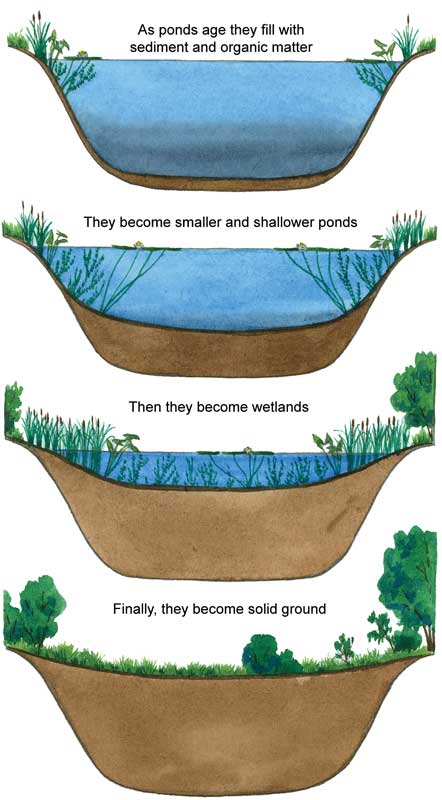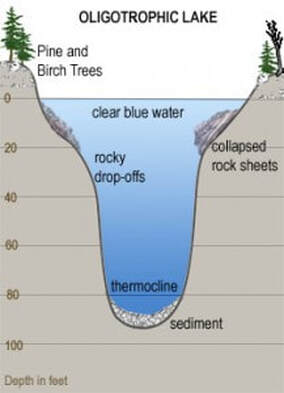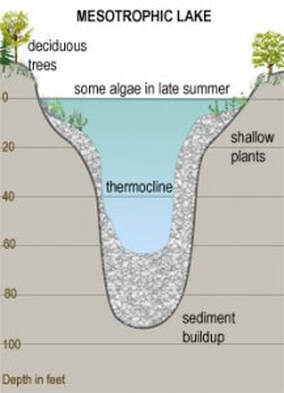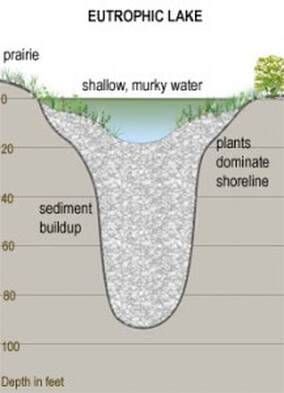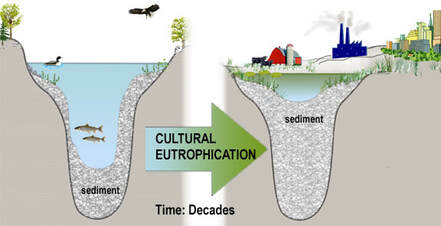Lakes are born, age, and pass away, usually over thousands or even millions of years.
However, human activities can accelerate this process.
However, human activities can accelerate this process.
Lake Succession...
|
Lakes change over time, often in predictable ways. This predictable process is called lake succession.
Generally, lake succession goes like this: 1. lake is deep with clear water and low productivity 2. sediment begins to accumulate and the lake gradually starts to fill in. 3. productivity increases as nutrients accumulate and feeds algae and aquatic plants (eutrophication) 4. lake becomes a shallow pond with a large percentage of aquatic plant cover 5. pond becomes a wetland with more plant encroachment 6. wetland becomes a meadow. This is a very generalized description that is most applicable to smaller lakes. The specific trajectory of succession and the amount of time the process takes depends on how the lake was formed, what occurs in the watershed, and other factors. Lake Lacawac is aging! Over the past 13,000 years, the lake has shrunk to roughly 60% of its original size and has accumulated roughly 35 feet of sediment!
|
https://texasaquaticscience.org/lakes-and-ponds-aquatic-science-texas/
|
Eutrophication is part of lake succession during which sediment and nutrients enter the lake from it's watershed, resulting in a shallower and more nutrient-rich lake. Typically, this process occurs over centuries and increases in nutrients correlate with increases in algae and plants–nutrients help feed these organisms resulting in a lot of growth!
During this process, lakes progress in trophic status from oligotrophic, to mesotrophic, to eutrophic.
During this process, lakes progress in trophic status from oligotrophic, to mesotrophic, to eutrophic.
Trophic State
Trophic states comprise the trophic state index which categorizes lakes based on their productivity and nutrient content. This helps identify and class lakes when studying them and may aid in comparing them to other lakes as well as make the regulation process for the lake easier. The three main trophic states are; oligotrophic, mesotrophic, and eutrophic.
https://www.rmbel.info/primer/lake-trophic-states-2/
Nutrients, particularly phosphorus and nitrogen, are typically limiting and essential nutrients for plants, algae, and all life. The trophic states range from low to high nutrients and are as seen above and described below:
- Oligotrophic lakes are very low in nutrients with blueish waters and are typically very deep with mineral bottoms. These lakes also have little algae and are colder due to greater depth, permitting for higher levels of dissolved oxygen.
- Mesotrophic lakes are middle ground and have an intermediate amount of nutrients in the water. These lakes are typically clear, can experience algal blooms in late summer with warmer temperatures.
- Eutrophic lakes have the highest levels of nitrogen and phosphorus. As nutrients become more available as a lake ages, productivity increases, more organisms live, die, and then are decomposed. The lake fills with organic matter from those dead organisms as well as sediment, making these lakes significantly more shallow. Waters become murky in these lakes. Since these lakes have high nutrient levels, they can support large amounts of algae and aquatic life. However, these lakes are more likely to become anoxic in the summer.
Lake Lacawac is usually considered a mesotrophic lake. However, it is sometimes described as a "dystrophic" lake because its low productivity is somewhat due to its dark color, not necessarily low nutrient content.
Natural Eutrophication vs Human Accelerated Aging
Under natural circumstances, lakes undergo eutrophication at different rates depending on a range of factors including lake type, geology, vegetation, etc. Natural eutrophication usually takes centuries. However, human activity can accelerate this process.
Any activity in the watershed that increases nutrient and/or sediment input to a lake can speed up eutrophication and lake succession. For example:
Any activity in the watershed that increases nutrient and/or sediment input to a lake can speed up eutrophication and lake succession. For example:
- Excessive use of fertilizer from agriculture, golf course, or lawn care can result in increased nitrogen and phosphorus inputs to a lake
- Development that increases the percentage of impervious surfaces can result in more runoff
- Shoreline erosion can increase sediment and nutrient inputs
- Improper septic system construction and maintenance can cause sewage leaks into lakes, increasing nutrient content.
Image from: https://www.rmbel.info/primer/lake-eutrophication/
The human impact to Lake Lacawac has been minimal compared to many other Pocono lakes. This is because the Lacawac watershed is protected, and has been for decades. There is no development, fertilizer application, or deforestation allowed in the Lacawac watershed. Septic generated from users of the Lodge and Ice House is pumped out of the watershed. However, Lake Lacawac is subjected to human impacts not limited by the watershed such as acid rain, mercury deposition, and climate change.
Consequences of Cultural Eutrophication: Anoxic Zones
- Anoxic zones may also be referred to as “dead zones” in bodies of water that result from full depletion of dissolved oxygen within water, making them inhabitable for many creatures.
- One of the main causes for depletion of oxygen is eutrophication. Eutrophication is a natural process in which nutrients, particularly phosphorus and nitrogen, as well as sediment are received from its surrounding watershed. Naturally, this process typically occurs over centuries but deposits of nutrients can be accelerated by human disturbance such as through agriculture, land use, and usage of fertilizers that contain those nutrients.
- Excessive nutrients result in extensive algal growth, particularly cyanobacteria (blue-green algae) that can result in algal blooms of potentially toxic organisms.
- Notably, the growth of such algae results in higher decomposition rates once the algae die. Decomposition of the algal blooms caused by excess nutrients by bacteria utilizes all of the dissolved oxygen within an area, resulting in a “dead zone”.
References
https://education.nationalgeographic.org/resource/lake.
https://education.nationalgeographic.org/resource/dead-zone
https://www.rmbel.info/primer/lake-eutrophication/
https://www.rmbel.info/primer/lake-trophic-states-2/
Location |
|
